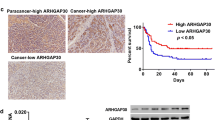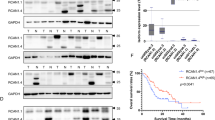Abstract
Angiopoietin-2 (Ang2) has been shown highly expressed in resected human pancreatic carcinoma samples, and has tightly combination with tumor angiogenesis, but the role in metastasis of it is less clear. We were, therefore, interested in exploring the effects of Ang2 silencing on the invasion and metastasis of pancreatic carcinoma. Lentivirus (LV)-mediated Ang2 small hairpin RNA (LV-RNAi) and mock lentivirus (LV-NC) were transfected into pancreatic carcinoma cell line MIA PaCa-2. Groups were designed in this study: the control group (MIA PaCa-2 cells), the LV-NC group (cells transfected with the LV-NC), the LV-RNAi-KD1 group (cells transfected with LV-RNAi of knock down sequence (1) and the LV-RNAi-KD2 group (cells transfected with LV-RNAi of knock down sequence (2). Boyden chamber transwell assay was used to detect the cell invasion change. The protein levels of Ang2, MMP-2, and MMP-9 gene and mRNA level of MMP-2, MMP-9 were detected by Western blot and real-time polymerase chain reaction, respectively. Orthotopic pancreatic carcinoma xenotransplantation model were successfully built with MIA PaCa-2 cells injection. After treatment with intraperitoneal injection of LV-RNAi-KD2 (LV-RNAi), mice growth, liver function test, tumor volume and peritoneal metastatic numbers were observed and counted. Moreover, expression of Ang2, MMP-2, MMP-9 were measured by immunohistochemistry. Ang2 expression were successfully knocked down in two LV-RNAi groups, especially in the LV-RNAi-KD2group. Compared with the control group and the LV-NC group, the mRNA and protein level of MMP-2 gene were downregulated significantly in LV-RNAi groups, also the invasion cell number decreased in boyden chamber transwell assay after LV-RNAi transfection. Meanwhile, no obvious MMP-9 gene expression changes were found among all the groups. LV-RNAi injection inhibited pancreatic carcinoma metastasis and growth in vivo by downregulating the expression of MMP-2 not MMP-9. Most importantly, LV-mediated gene therapy with Ang2 knockdown exhibited almost no toxicity in vivo. These findings demonstrate that Ang2 gene silencing exert an anti-metastasis effect in vitro and in vivo, and Ang2 targeted gene therapy has the potential to serve as a novel way for pancreatic carcinoma treatment.






Similar content being viewed by others
Abbreviations
- Ang2:
-
Angiopoietin-2
- LV:
-
Lentivirus
- RNAi:
-
RNA interference
- GFP:
-
Green fluorescent protein
- LV-NC:
-
The mock lentivirus
- MOI:
-
Multiplicity of infection
References
Hidalgo, M. (2010). Pancreatic cancer. New England Journal of Medicine, 362(17), 1605–1617.
Duan, X., Deng, L., Chen, X., Lu, Y., Zhang, Q., Zhang, K., et al. (2011). Clinical significance of the immunostimulatory MHC class I chain-related molecule A and NKG2D receptor on NK cells in pancreatic cancer. Medical Oncology, 28(2), 466–474.
Yao, J., & Qian, C. (2010). Inhibition of Notch3 enhances sensitivity to gemcitabine in pancreatic cancer through an inactivation of PI3K/Akt-dependent pathway. Medical Oncology, 27(3), 1017–1022.
Ghadially, R. (2011). The role of stem and circulating cells in cancer metastasis. Journal of Surgical Oncology, 103(6), 555–557. doi:10.1002/jso.21807.
Chaffer, C. L., & Weinberg, R. A. (2011). A perspective on cancer cell metastasis. Science, 331(6024), 1559–1564.
Hu, B., & Cheng, S. Y. (2009). Angiopoietin-2: Development of inhibitors for cancer therapy. Current Oncology Reports, 11(2), 111–116.
Lewis, C. E., De Palma, M., & Naldini, L. (2007). Tie2-expressing monocytes and tumor angiogenesis: Regulation by hypoxia and angiopoietin-2. Cancer Research, 67(18), 8429–8432.
Zhou, J., Zhang, Z. X., Zhao, H., Zhu, D. M., Zhang, Y., & Li, D. C. (2011). Anti-angiogenesis by lentivirus-mediated small interfering RNA silencing of angiopoietin-2 gene in pancreatic carcinoma. Technology in Cancer Research and Treatment, 10(4), 361–369.
Lares, M. R., Rossi, J. J., & Ouellet, D. L. (2010). RNAi and small interfering RNAs in human disease therapeutic applications. Trends in Biotechnology, 28(11), 570–579.
Nijwening, J. H., & Beijersbergen, R. L. (2010). Using large-scale RNAi screens to identify novel drug targets for cancer. IDrugs, 13(11), 772–777.
Haugk, B. (2010). Pancreatic intraepithelial neoplasia-can we detect early pancreatic cancer? Histopathology, 57(4), 503–514. doi:10.1111/j.1365-2559.2010.03610.x.PMID:20875068.
Ryozawa, S., Iwano, H., Taba, K., Sen-yo, M., & Uekitani, T. (2011). Genetic diagnosis of pancreatic cancer using specimens obtained by EUS-FNA. Digestive Endoscopy, 23(Suppl 1), 43–45. doi:10.1111/j.1443-1661.2011.01117.x.
Plentz, R. R., Manns, M. P., & Greten, T. F. (2010). Molecular therapy of pancreatic cancer. Minerva Endocrinologica, 35(1), 27–33.
Shapiro, R., Strydom, D. J., Olson, K. A., & Vallee, B. L. (1987). Isolation of angiogenin from normal human plasma. Biochemistry, 26(16), 5141–5146.
Fukuhara, S., Sako, K., Noda, K., Zhang, J., Minami, M., & Mochizuki, N. (2010). Angiopoietin-1/Tie2 receptor signaling in vascular quiescence and angiogenesis. Histology and Histopathology, 25(3), 387–396.
Eklund, L., & Olsen, B. R. (2006). Tie receptors and their angiopoietin ligands are context-dependent regulators of vascular remodeling. Experimental Cell Research, 312(5), 630–641.
Imanishi, Y., Hu, B., Xiao, G., Yao, X., & Cheng, S. Y. (2011). Angiopoietin-2, an angiogenic regulator, promotes initial growth and survival of breast cancer metastases to the lung through the integrin-linked kinase (ILK)-AKT-B cell lymphoma 2 (Bcl-2) pathway. Journal of Biological Chemistry, 286(33), 29249–29260.
Sallinen, H., Heikura, T., Laidinen, S., Kosma, V. M., Heinonen, S., Ylä-Herttuala, S., et al. (2010). Preoperative angiopoietin-2 serum levels: A marker of malignant potential in ovarian neoplasms and poor prognosis in epithelial ovarian cancer. International Journal of Gynecological Cancer, 20(9), 1498–1505.
Volkova, E., Willis, J. A., Wells, J. E., Robinson, B. A., Dachs, G. U., & Currie, M. J. (2011). Association of angiopoietin-2, C-reactive protein and markers of obesity and insulin resistance with survival outcome in colorectal cancer. British Journal of Cancer, 104(1), 51–59.
Imanishi, Y., Hu, B., Jarzynka, M. J., Guo, P., Elishaev, E., Bar-Joseph, I., et al. (2007). Angiopoietin-2 stimulates breast cancer metastasis through the alpha(5)beta(1) integrin-mediated pathway. Cancer Research, 67(9), 4254–4263.
Hashizume, H., Falcon, B. L., Kuroda, T., Baluk, P., Coxon, A., Yu, D. Y., et al. (2010). Complementary, actions of inhibitors of angiopoietin-2 and VEGF on tumor angiogenesis and growth. Cancer Research, 70(6), 2213–2223. doi:10.1158/0008-5472.
Doyle, J. L., & Haas, T. L. (2009). Differential role of beta-catenin in VEGF and histamine-induced MMP-2 production in microvascular endothelial cells. Journal of Cellular Biochemistry, 107(2), 272–283.
Liotta, L. A., & Kohn, E. C. (2001). The microenvironment of the tumour-host interface. Nature, 411(6835), 375–379.
He, Y., Liu, X. D., Chen, Z. Y., Zhu, J., Xiong, Y., Li, K., et al. (2007). Interaction between cancer cells and stromal fibroblasts is required for activation of the uPAR–uPA–MMP-2 cascade in pancreatic cancer metastasis. Clinical Cancer Research, 13(11), 3115–3124.
Kenny, H. A., & Lengyel, E. (2009). MMP-2 functions as an early response protein in ovarian cancer metastasis. Cell Cycle, 8(5), 683–688.
Author information
Authors and Affiliations
Corresponding author
Additional information
Zi-Xiang Zhang and Jin Zhou have contributed equally to this study.
Rights and permissions
About this article
Cite this article
Zhang, ZX., Zhou, J., Zhang, Y. et al. Knockdown of Angiopoietin-2 Suppresses Metastasis in Human Pancreatic Carcinoma by Reduced Matrix Metalloproteinase-2. Mol Biotechnol 53, 336–344 (2013). https://doi.org/10.1007/s12033-012-9532-9
Published:
Issue Date:
DOI: https://doi.org/10.1007/s12033-012-9532-9




